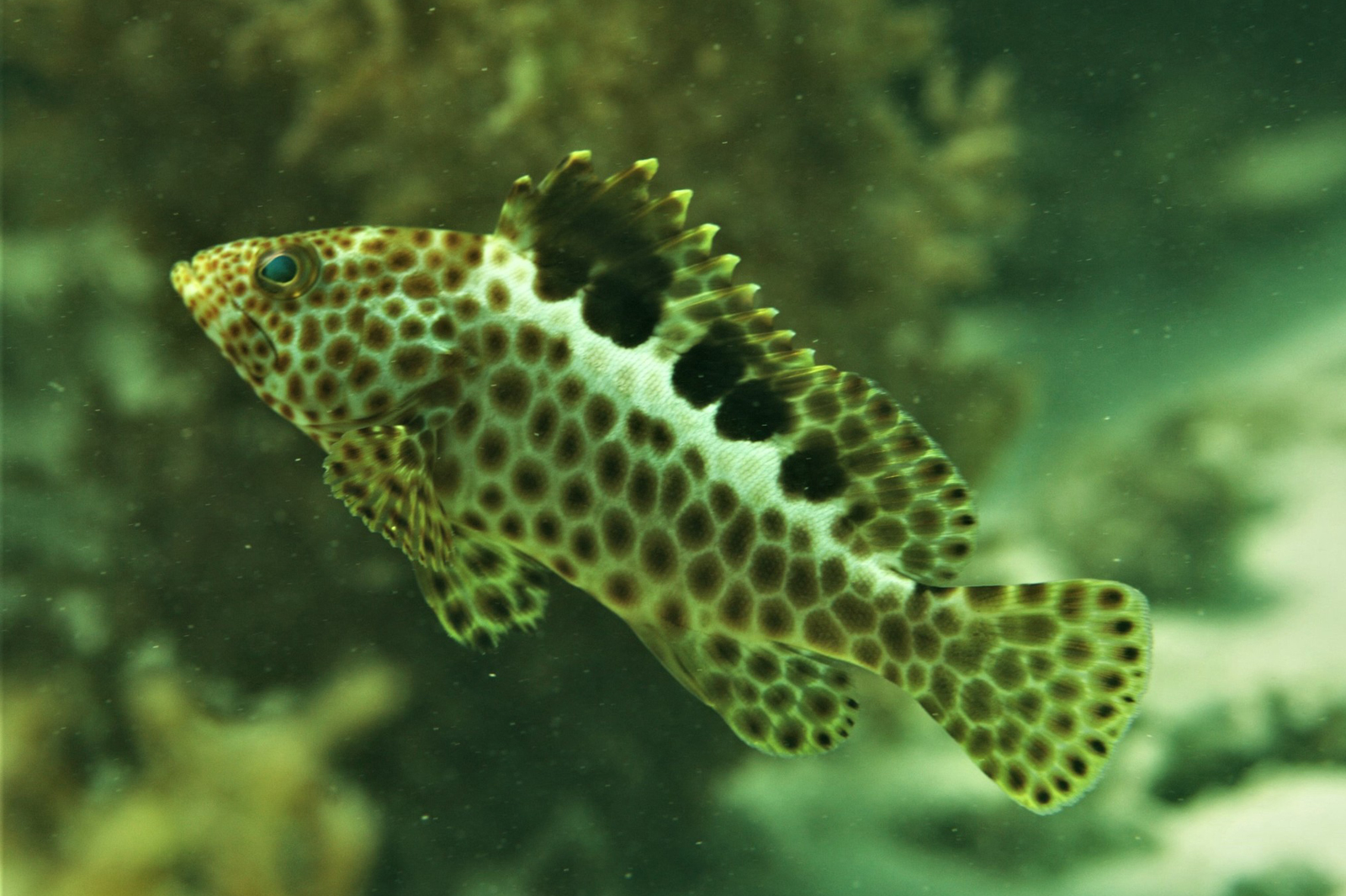Frostback Rockcod, Epinephelus bilobatus Randall & Allen 1987
Other Names: Brown-spotted Rock-cod, Frostback Cod, Honeycomb Cod, Twinspot Grouper

A juvenile Frostback Rockcod, Epinephelus bilobatus, at Exmouth, Western Australia, April 2015. Source: John Sear / iNaturalist.org. License: CC By Attribution-NonCommercial
Summary:
An overall greyish-brown grouper densely covered in hexagonal golden-brown spots, a whitish area along the back, 2-3 large dark bilobed blotches along the dorsal-fin base, and a lunate tail.
The Frostback Rockcod is often confused with other 'reticulated groupers'.
The Frostback Rockcod is often confused with other 'reticulated groupers'.
Cite this page as:
Bray, D.J. 2018, Epinephelus bilobatus in Fishes of Australia, accessed 26 Apr 2024, https://fishesofaustralia.net.au/home/species/3851
Frostback Rockcod, Epinephelus bilobatus Randall & Allen 1987
More Info
|
Distribution |
From the Houtman Abrolhos Islands, Western Australia, to the Arafura Sea, northeast of the Cobourg Peninsula, Northern Territory. Elsewhere, this species occurs in West Papua, Indonesia. Inhabits coastal reefs with weedy areas and scattered coral patches. |
|
Features |
Dorsal fin XI, 17-18; Anal fin III, 8. Body scales ctenoid, cycloid scales anterodorsally on thorax and ventrally on abdomen; body with auxiliary scales; greatest depth of body 2.8-3.3 in SL; rounded caudal fin; pelvic fins 1.8-2.1 in head length; preopercle subangular, with serrae at the angle slightly enlarged; opercular spines inconspicuous; straight or slightly concave upper edge of operculum; nostrils subequal in small fish, but posterior nostril diameter about twice of that of anterior nostril in a fish of 27 cm SL; maxilla reaches below rear half of eye; 2 rows of small teeth on midlateral part of lower jaw. |
|
Colour |
Overall greyish-brown with hexagonal brown spots; white strip at back; dorsal fin base with 2-3 dark bilobed spots. |
|
Similar Species |
Differs from the similar dark spotted, Western Pacific Epinephelus maculatus in usually having 17 vs. 16 soft dorsal-fin rays, fewer gill rakers, fewer scales in longitudinal series (97-102 vs. 103-120 for E. maculatus), and in having longer dorsal-fin spines, the longest 2.05-2.3 in head (vs. 2.2-2.7 for E. maculatus). The two species also differ in colour: E. maculatus lacks the series of large dark spots along the dorsal-fin base, instead having two large blackish areas in the fin, one anteriorly on the spinous portion and one centred at the origin of the soft portion. |
|
Etymology |
The species is named bilobatus in reference to its most characteristic colour markings, a series of three bilobed or close-set pairs of dark brown spots along the base of the dorsal fin. |
|
Species Citation |
Epinephelus bilobatus Randall & Allen 1987, Rec. W. A. Mus. 13(3): 406, fig. 4. Type locality: Rosemary Island, Dampier Archipelago, Western Australia [20°28´S, 116°36´E]. |
|
Author |
Bray, D.J. 2018 |
|
Resources |
Frostback Rockcod, Epinephelus bilobatus Randall & Allen 1987
References
Allen, G.R. 1997. Marine Fishes of Tropical Australia and South-east Asia. Perth : Western Australian Museum 292 pp. 106 pls.
Allen, G.R. & Swainston, R. 1988. The Marine Fishes of North-Western Australia. A field guide for anglers and divers. Perth, WA : Western Australian Museum vi 201 pp., 70 pls.
Craig, M.T., Sadovy de Mitcheson, Y.J. & Heemstra, P.C. 2011. Groupers of the World: a Field and Market Guide. Grahamstown, South Africa : NISC Ltd 356 pp., Appendix 47 pp.
Heemstra, P.C. & Randall, J.E. 1993. Groupers of the World (Family Serranidae, Subfamily Epinephelinae). An annotated and illustrated catalogue of grouper, rockcod, hind, coral grouper and lyretail species known to date. FAO Fisheries Synopsis No. 125 Vol. 16. Rome: FAO. pp. 1-382.
Heemstra, P.C. & Randall, J.E. 1999. Family Serranidae. pp. 2442-2548 in Carpenter, K.E. & Niem, T.H. (eds). The Living Marine Resources of the Western Central Pacific. FAO Species Identification Guide for Fisheries Purposes. Rome : FAO Vol. 4 pp. 2069-2790.
Hutchins, J.B. 2001. Biodiversity of shallow reef fish assemblages in Western Australia using a rapid censusing technique. Records of the Western Australian Museum 20: 247-270.
Ma, K.Y. & Craig, M.T. 2018. An Inconvenient Monophyly: An Update on the Taxonomy of the Groupers (Epinephelidae). Copeia 106(3): 443–456. https://doi.org/10.1643/CI-18-055
Randall, J.E. & Allen, G.R. 1987. Four new serranid fishes of the genus Epinephelus (Perciformes: Epinephelinae) from Western Australia. Records of the Western Australian Museum 13(3): 387-411. PDF Open Access
Randall, J.E. & Heemstra, P.C. 1991. Revision of Indo-Pacific groupers (Perciformes: Serranidae: Epinephelinae), with descriptions of five new species. Indo-Pacific Fishes 20: 1-332.
Rhodes, K., Russell, B. & Pollard, D. 2008. Epinephelus bilobatus. The IUCN Red List of Threatened Species 2008: e.T132752A3441389. http://dx.doi.org/10.2305/IUCN.UK.2008.RLTS.T132752A3441389.en . Downloaded on 13 November 2015.
Sainsbury, K.J., Kailola, P.J. & Leyland, G.G. 1985. Continental Shelf Fishes of Northern and North-Western Australia. Canberra : Fisheries Information Service 375 pp. figs & pls. (p. 132, as Epinephelus maculatus)








